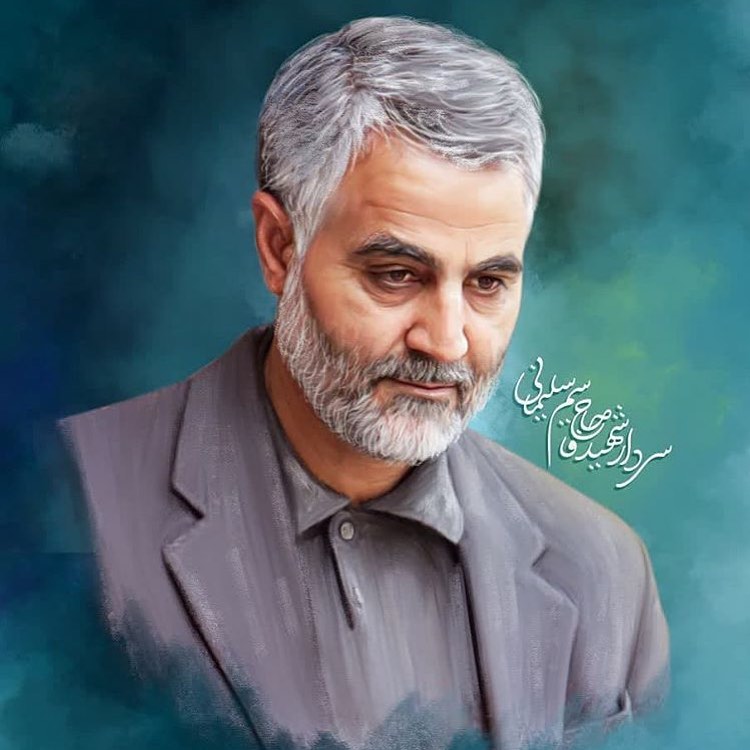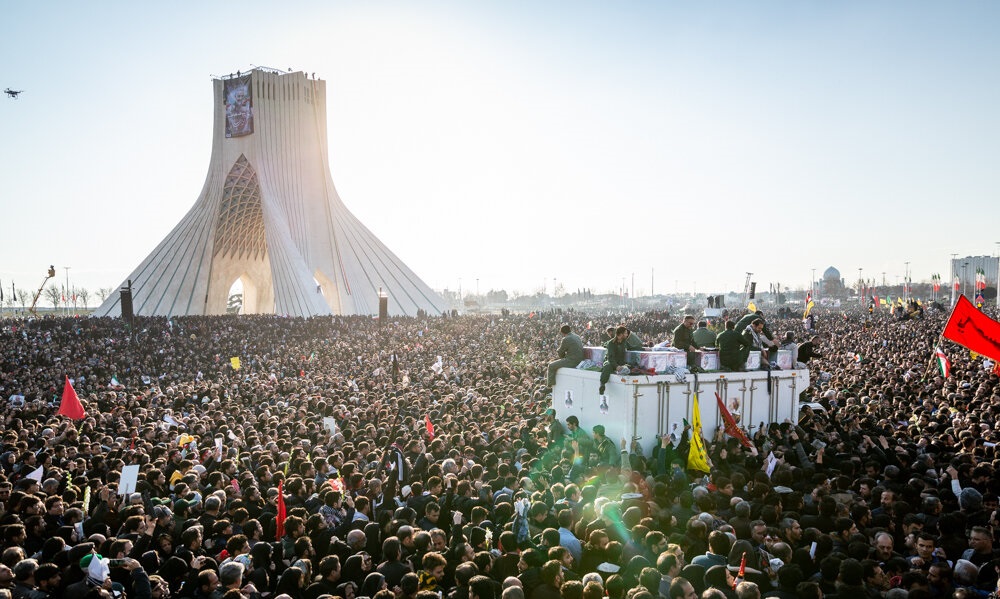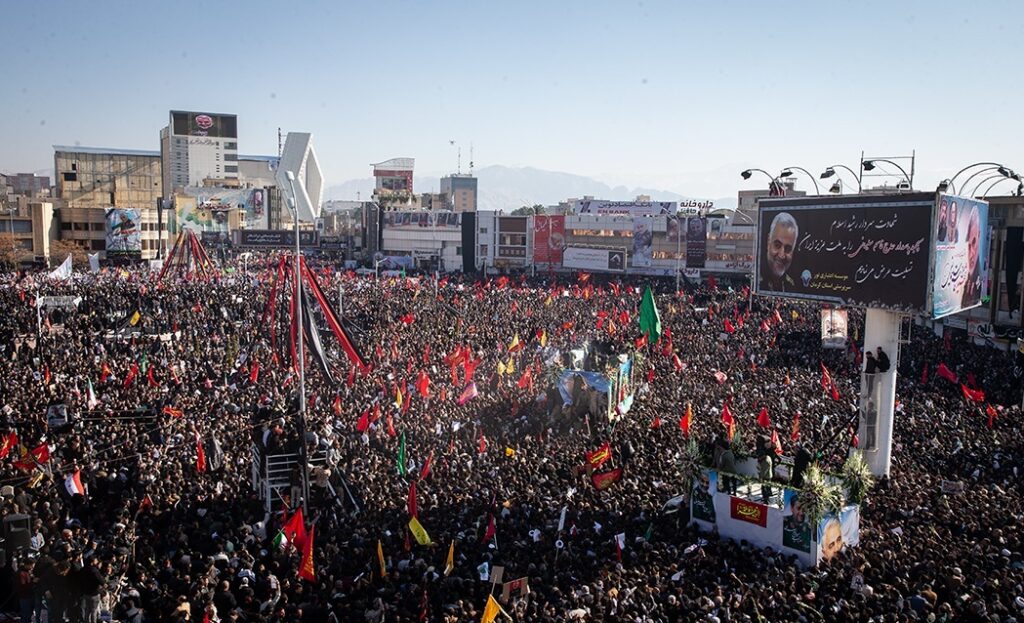Qāsem Soleimānī (Persian: قاسم سلیمانی) (b. 1957 – d. 2020), was the commander of the Quds Force of Islamic Revolutionary Guard Corps and was assassinated by US forces in Iraq in 2020 CE.
During Iran-Iraq war (1980-1988), he was the commander of Tharallah 41 Division and one of the commanders in the operations Wa-l-Fajr 8, Karbala 4, and Karbala 5. In 2001, Qasem Soleimani was appointed by Ayatollah Khamenei, the Supreme Leader of Islamic Republic of Iran, as the commander of the Quds Force. After the emergence of ISIS in Iraq and Syria, Soleimani played a significant role in fighting this terrorist group.
He was martyred on Jumada I 7, 1441/January 3, 2020 by American forces in Baghdad. After his martyrdom in 2020, Soleimani was promoted to the rank of Lieutenant General.

Life of Mr. Qasem Soleimani
Qasem Soleimani, son of Hasan, was born on March 11, 1957 in Rabor, a small town in Kerman province, Iran. He was employed in Kerman’s Water and Wastewater Company when he was eighteen. During the events that led to the Islamic Revolution of Iran, he was acquainted with Reza Kamyab, a cleric from Mashhad, who encouraged him to participate in the activities against the Pahlavi regime. He was one of the main leaders of the protests in Kerman during the revolution.
During Iran-Iraq War
After the Islamic Revolution of Iran, Qasem Soleimani joined the Islamic Revolutionary Guard Corps (IRGC) in 1981 and when the war between Iran and Iraq started, he trained a number of battalions in Kerman and sent them to the fronts.
For some time, he was the commander of the IRGC in Western Azerbaijan province. In 1982, Soleimani was appointed by Muhsen Reza’ei, the head of the IRGC, as the commander of the Tharallah 41 Division.
During the war with Iraq, he was also one of the commanders of the operations Wa-l-Fajr 8, Karbala 4, and Karbala 5. The latter was one of the most crucial operations during the eight-year war, which weakened the political and military positions of the Ba’thi Iraqi army and changed the situation in favor of Iranian military forces.
After the end of the war in 1989, Soleimani returned to Kerman and engaged in combating the insurgents led by the enemies of Iran outside the eastern Iranian borders. Prior to being appointed to the command of the Quds Force, Soleimani engaged in combating the drug dealers on the borders of Iran and Afghanistan.
On January, 2011, Soleimani was promoted to the rank of Major general by the Supreme leader, Ayatollah Khamenei.
On January 3 2020, Soleimani was promoted to the rank of lieutenant general after he was martyred.
Command of Quds Force
Qasem Soleimani was appointed by Ayatollah Khamenei, the Supreme Leader of Iran, as the commander of the IRGC’s Quds Force. According to a report by the Israeli intelligence services, the Quds Force was established in 1990 to boost Iranian activities outside its borders.
After Ahmad Vahidi, Soleimani became the second commander of the Quds force. According to Israeli sources, Qasem Soleimani played a major role in expanding the influence of Iran in the Middle East and especially in the Arab Spring countries.
According to the same source, through Qasem Soleimani’s strategies, Iran deepened its influence in Iraq, Syria, and Yemen.
A Part of Ayatollah Khamenei’s letter to Soleimani regarding the end of ISIS’s rule: “By eradicating the tumor of ISIS, not only you did a great service to the countries in region and in the Muslim world but also to humanity.”
Role in Iraq and Syria and Combating ISIS
Soleimani was a prominent commander in the battle against ISIS in Iraq and Syria. ISIS is an extremist group, which appeared after the fall of Saddam Husein and in the absence of a powerful rule in Iraq. Iran started combating this group for the security of the region.
According to ISNA, in 2011, the forces under Soleimani’s command, including the Fatimiyyun Division and the Zaynabiyyun Brigade, went to Syria to fight ISIS and other extremist groups. In 2014, Mosul was conquered by ISIS and Baghdad was almost conquered by them as well.
Organizing parts of the Popular Mobilization Forces (PMF), Soleimani played a major role in driving away the ISIS from Iraq. Haider al-Abadi, the Iraqi prime minister of the time, called Soleimani as a major partner in fighting ISIS.
In November 21, 2017, Soleimani wrote a letter to Ayatollah Khamenei, announcing the end of ISIS’s rule.
Haaretz accused Soleimani of having a role in the missile strikes against Israel and Jews in the world.
Receiving the Dhu l-Fiqar Sign
In March 10, 2019, Ayatollah Khamenei, granted Soleimani the Dhu l-Fiqar sign, which is granted to high ranking military commanders whose commandership leads to significant results or victories. After the Islamic Revolution in 1979, Soleimani was the first commander who received this sign.
Global Status
In 2019, the American magazine Foreign Policy, listed Qasem Soleimani among the one-hundred top global defense and security thinkers.
The martyrdom of Mr. Qasem Soleimani
Qasem Soleimani was assassinated on Jumada I 7, 1441/January 3, 2020, together with Abu Mahdi al-Muhandes, deputy chief of the Popular Mobilization Forces of Iraq, as well as some others, by the American forces near Baghdad airport in their car.
Reactions
Soleimani’s martyrdom led to waves of protest in different countries throughout the world, and many mourning ceremonies were held for him in different cities in Iran and other countries.
Many political and religious figures reacted to his assassination. In his statement on Soleimani’s martyrdom, Ayatollah Khamenei called him the international figure of resistance and announced three days of national mourning in Iran.
Other political and religious figures, including the heads of the three branches of the Iranian government and religious authorities (maraji’) in Iran and Iraq, praised Soleimani’s bravery, sincerity, and self-sacrifice in their statements.
Sayyid Hasan Nasrallah (the Secretary General of Hezbollah), Sayyid Abd al-Malik al-Houthi (the leader of Ansar Allah in Yemen), and the presidents of Syria, Lebanon, Iraq, and Turkey were among other non-Iranian political figures who condemned the assassination of Soleimani.
Moreover, prime ministers of many foreign countries expressed their sympathy with Iran and condemned America’s crime.
Agnès Callamard, the Special Rapporteur at the office of the United Nations High Commissioner for Human Rights (OHCHR), announced the assassination of Qasem Soleimani and Abu Mahdi al-Muhandes to be illegal and a violation of international law.
Ervand Abrahamian, the American historian, also stated that Iranians used to regard the US as a conspiring government against them but from now on they will consider it a terrorist government. Michael Moore, the American film-maker, also objected to the assassination and implied that the American Government was warmonger.


Results
Ratification of ousting the American forces from Iraq
After the martyrdom of Soleimani and al-Muhandes, a number of Iraqi people and political groups called for ousting the American forces from Iraq and thus the Iraqi parliament ratified on January 5, 2020 the expelling of the Americans. It is noteworthy that prior to that and after the Americans attacked the bases of the Popular Mobilization Forces, several people and groups had demanded the American forces to be ousted. Ayatollah Sayyid Kazim Ha’iri also had issued a fatwa, declaring the prohibition of allowing the American forces to stay in Iraq.
Iran’s Retaliation
In the early hours of January 8, 2020, Iran’s IRGC launched several ballistic missiles at Ain al-Asad, a major air base used mainly by American forces, as well as another American air base in Erbil in retaliation for the assassination of Qasem Soleimani.
Burial Ceremony
The burial ceremonies of Qasem Soleimani together with Abu Mahdi al-Muhandes and other martyrs were held on January 4, 2020 in Baghdad, Karbala, and Najaf with the presence of Iraqi political and religious figures and many other people. Afterwards, the bodies were taken to Iran, and the burial ceremonies were held with the presence of millions of people in Ahwaz and Mashhad on January 5, 2020 and in Tehran and Qom on January 6, 2020. Then, the final ceremony was held on January 7, in Kerman, where Soleimani was buried.
According to Russia Today Arabic, the gathering of people for Soleimani’s burial ceremony was the second largest such gathering after the gathering for Imam Khomeini‘s burial ceremony.
References : The material for this article is mainly taken from قاسم سلیمانی in Farsi WikiShia.